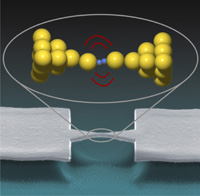The ultimate goal of nanotechnology is to use products for the field of electronics has progressed a whole step - a very small mechanical switch and a new type of electronic switch

The smallest mechanical switch plus an electronic switch of a type never seen before. This is the way in which the physicist Marius Trouwborst summarizes the results of his doctoral thesis on electric current through atoms and particles. "The ultimate goal of nanotechnology is to use particles for the field of electronics," he explains. "This goal has now advanced a whole step."
The enormous progress in information technology is mainly due to the fact that the electronic components in computers are getting smaller and smaller. And smaller means of course - faster and cheaper. Over the past four decades, the number of transistors in a computer has doubled every two years. However, within a decade we will reach the physical limit, the researcher estimates. At this limit, the basic principles of the transistor no longer work properly.
If we want to continue developing faster computers we have to invent new methods. One option for this is the use of atoms and separates. This scientist's basic research on the passage of electrons through individual atoms and particles is exactly suited to this type of hunting.
During his research, Marius developed an innovative method for arranging gold atoms so that a very tiny mechanical switch can be built from them - only a single atom of gold makes the contact. In addition, he managed to build a state-of-the-art electronic switch with the same dimensions.
The method works using what is called a "break junction". First, fix a gold wire into a flexible strip of plastic. Now, by carefully bending the strip, the gold thread stretches, similar to chewing gum. Just before breaking, the wire has a thickness of a single gold atom. Another very careful bending (on a nanometer scale) moves the edges away from each other a little. Although the threads are now separated, the break is not complete. As soon as the strip is carefully bent back, the ends of the threads merge again.
The researcher repeated this bending back and forth numerous times, in a highly controlled manner. Each time the wire is torn, the atoms at both ends are arranged differently. The researcher discovered that this reorganization gradually becomes more and more orderly. In the end, the atoms look like pyramids of carefully packed billiard balls with the apex of the pyramid being a single atom of gold. "By moving the edges back and forth to a distance of only a tenth of a nanometer, the aforementioned switch can be turned on and off," says the researcher.
Moreover, the system allows for the confinement of a single ferro between the ends. This is useful for examining the electronic properties of that insulator. When an electrical voltage is applied to the ends, all the electronic charge passes through this single cell in the middle.
The researcher used hydrogen atoms in this work. When the voltage is increased, the hydrogen atoms begin to vibrate between the ends of the gold wires. The researcher discovered that the resistance changes suddenly and decreases sharply. "You can simply turn the system on and off by vibrating the parts or stopping it," explains the researcher. "This kind of switch has not been seen before."
Although it is closely related to the vibrating mares, the exact cause of this tickling behavior is still unknown. The researcher suspects that the reason lies in some kind of phase transition. More research is still needed before such switches can be useful. However, "what is already clear," the researcher points out, "is that the method provides new insights into the ways in which cells can be used as functional structural units in tomorrow's electronics."

5 תגובות
One of the most interesting news lately.
And this is because the technology here has reached, in my opinion, an insurmountable limit.
A student cell.
As with everything in Israel, we are more advanced than the rest of the world.
For example, we have enough citizens with a switch smaller than a single gold atom.
I wonder what current a single atom can transfer...
Where is Israel in this field??
Approaching the point